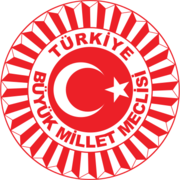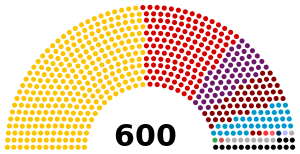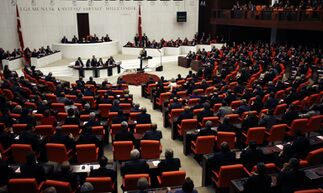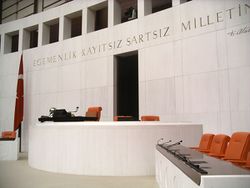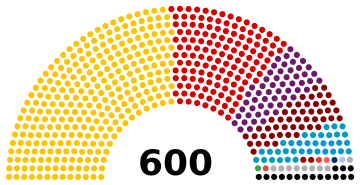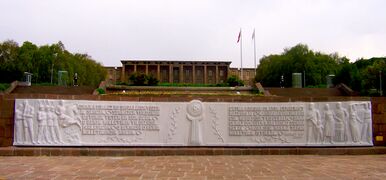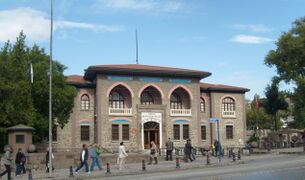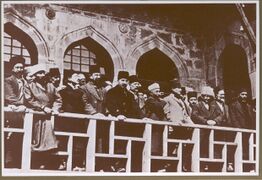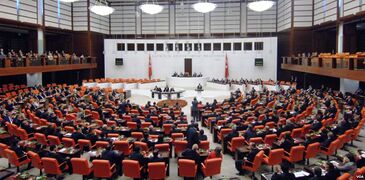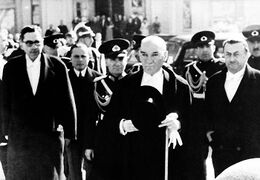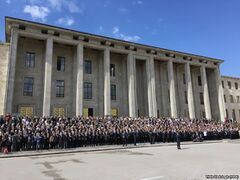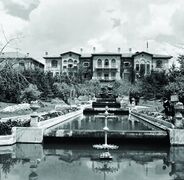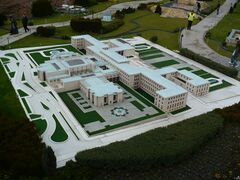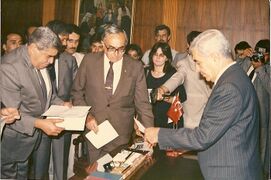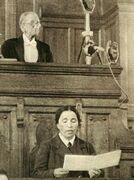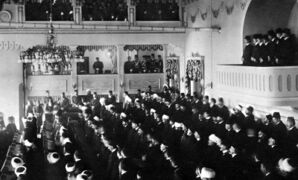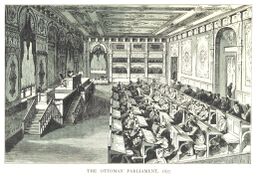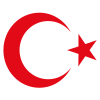المجلس الوطني الأكبر لتركيا
| ||||||||||||||||||||||||||||||||||||||||||||||||||||||||||||||
| ||||||||||||||||||||||||||||||||||||||||||||||||||||||||||||||
الجمعية الوطنية الكبرى أو المجلس الوطني الأكبر أو البرلمان التركي هو الهيئة التشريعية الوحيدة المخولة النظر وتعديل الدستور التركي. تأسس في أنقرة في 23 أبريل 1920 في خضم حرب الإستقلال التركية. يتكون من 550 عضو ينتخبون كل خمس سنوات في 85 دائرة مقسمة حسب المحافظات الإحدى والثمانين بإضافة إلى أن اسطنبول تنقسم إلى ثلاث دوائر انتخابيه بينما أنقرة وأزمير وتنقسم إلى قسمين وذلك بسبب كثرة عدد السكان.

التاريخ
لتركيا تاريخ من الحكم الدستوري قبل تأسيس البرلمان الوطني الحالي. These include attempts at curbing absolute monarchy during the Ottoman Empire through constitutional monarchy, as well as establishments of caretaker national assemblies immediately prior to the declaration of the Republic of Turkey in 1923 but after the de facto dissolution of the Ottoman Empire earlier in the decade.
الحياة البرلمانية قبل العصر الجمهوري
الدولة العثمانية
There were two periods of parliamentary governance during the Ottoman Empire. The First Constitutional Era lasted for only two years, elections being held only twice. After the first elections, there were a number of criticisms of the government due to the Russo-Turkish War, 1877–1878 by the representatives, and the assembly was dissolved and an election called on 28 June 1877. The second assembly was also dissolved by the Sultan Abdul Hamid II on 14 February 1878, the result being the return of absolute monarchy with Abdul Hamid II in power and the suspension of the Ottoman constitution of 1876, which had come with the democratic reforms resulting in the First Constitutional Era.[1]
The Second Constitutional Era began on 23 July 1908 with the Young Turk Revolution. The constitution that was written for the first parliament included control of the sultan on the public and was removed during 1909, 1912, 1914 and 1916, in a session known as the "declaration of freedom". Most of the modern parliamentary rights that were not granted in the first constitution were granted, such as the abolition of the right of the Sultan to deport citizens that were claimed to have committed harmful activities, the establishment of a free press, a ban on censorship. Freedom to hold meetings and establish political parties was recognized, and the government was held responsible to the assembly, not to the sultan.[2]
During the two constitutional eras of the Ottoman Empire, the Ottoman parliament was called the General Assembly of the Ottoman Empire and was bicameral. The upper house was the Senate of the Ottoman Empire, the members of which were selected by the sultan.[3] The role of the Grand Vizier, the centuries-old top ministerial office in the empire, transformed in line with other European states into one identical to the office of a Prime Minister, as well as that of the speaker of the Senate. The lower chamber of the General Assembly was the Chamber of Deputies of the Ottoman Empire, the members of which were elected by the general public.[4]
تأسيس البرلمان الوطني
After World War I, the victorious Allied Powers sought the dismemberment of the Ottoman Empire through the Treaty of Sèvres.[5] The sovereign existence of the Turkish nation was to be eliminated under these plans, except for a small region. Nationalist Turkish sentiment rose in the Anatolian peninsula, engendering the establishment of the Turkish national movement. The political developments during this period have made a lasting impact which continues to affect the character of the Turkish nation. During the Turkish War of Independence, Mustafa Kemal put forth the notion that there would be only one way for the liberation of the Turkish people in the aftermath of World War I, namely, through the creation of an independent, sovereign Turkish state. The Sultanate was abolished by the newly founded parliament in 1922, paving the way for the formal proclamation of the republic that was to come on 29 October 1923.[6]
العبور للدستور الوطني
العصر الجمهوري
1923 – 1945
الناطق بإسم البرلمان
الناطق الحالي بإسم البرلمان هو كوكسال طوپطان من JDP، والذي اُنتُخب في 9 أغسطس 2007. وهو الناطق بإسم برلمان تركيا الثالث والعشرون.
المجموعات البرلمانية
اللجان
اللجان المتخصصة
- Constitution committee (26 members)
- Justice committee (24 members)
- National Defense committee (24 members)
- Internal affairs committee (24 members)
- Foreign affairs committee (24 members)
- National Education, Culture, Youth and Sports committee (24 members)
- Development, reconstruction, transportation and tourism committee (24 members)
- Environment committee (24 members)
- Health, family, employment, social works committee (24 members)
- Agriculture, forestry, rural works committee (24 members)
- Industry, Commerce, Energy, Natural Resources, Information and Technology Committee (24 members)
- Committee for checking GNAT Accounts (15 members)
- Application committee (13 members)
- Planning and Budget committee (39 members)
- Public enterprises committee (35 members)
- Committee on inspection of Human rights (23 members)
- Committee on EU Adjustment (21 members) (not available in Parliamentary Procedures)
لجان البحث البرلمانية
التشكيل الحالي
The 27th Parliament of Turkey took office on 7 July 2018, following the ratification of the results of the general election held on 24 June 2018. The composition of the 27th Parliament, is shown below.
Since the elections, 3 MPs deceased, 5 MPs became ministers, 5 MPs became mayors and 3 MPs lost their memberships.[7]
التغيرات منذ مارس 2020
نتائج آخر انتخابات

| |||||||||
|---|---|---|---|---|---|---|---|---|---|
| الائتلاف | الحزب | الأصوات | المقاعد | ||||||
| # | % | ± | # | ± | % | ||||
| اتفاق الجمهور Cumhur İttifakı |
حزب العدالة والتنمية* Adalet ve Kalkınma Partisi |
21,335,579 | 42.56 | -6.94 | 295 | -22 | 49.17 | ||
| حزب الحركة القومية Milliyetçi Hareket Partisi |
5,564,517 | 11.10 | -0.80 | 49 | +9 | 8.17 | |||
| إجمالي اتفاق الجمهور | 26,900,096 | 53.66 | -7.74 | 344 | -13 | 57.33 | |||
| الاتفاق الملي Millet İttifakı |
حزب الشعب الجمهوري* Cumhuriyet Halk Partisi |
11,348,899 | 22.64 | -2.68 | 146 | +12 | 24.33 | ||
| الحزب الجيد* İyi Parti |
4,990,710 | 9.96 | New | 43 | New | 7.17 | |||
| حزب السعادة* Saadet Partisi |
673,731 | 1.34 | +0.66 | 0 | ±0 | 0.00 | |||
| إجمالي الاتفاق الملي | 17,013,340 | 33.94 | +7.94 | 189 | +55 | 31.50 | |||
| حزب الشعوب الديمقراطي Halkların Demokratik Partisi |
5,866,309 | 11.70 | +0.94 | 67 | +8 | 11.17 | |||
| حزب الدعوة الحرة Hür Dava Partisi |
157,612 | 0.31 | +0.31 | 0 | ±0 | 0.00 | |||
| حزب الوطن Vatan Partisi |
117,779 | 0.23 | -0.02 | 0 | ±0 | 0.00 | |||
| غيرهم Diğer |
75,283 | 0.15 | -1.44 | 0 | ±0 | 0.00 | |||
| الأصوات الباطلة/الفارغة | 1,053,310 | – | – | – | – | – | |||
| الإجمالي | 51,183,729 | 100.00 | – | 600 | +50 | 100.00 | |||
| الأصوات المسجلة/الإقبال | 59,354,840 | 86.23 | +1.05 | – | – | – | |||
| المصدر: وكالة الأناضول[dead link] | |||||||||
| *ملاحظات: عضوان من حزب السعادة اِنتـُخـِبا على قائمة حزب الشعب الجمهوري، عضو من الحزب الديمقراطي اِنتـُخـِب على قائمة الحزب الجيد، وعضو من حزب الاتحاد الكبير اِنتـُخـِب على قائمة حزب العدالة والتنمية. | |||||||||
مبنى البرلمان
The current Parliament Building is the third to house the nation's parliament. The building which first housed the Parliament was converted from the Ankara headquarters of the Committee of Union and Progress, the political party that overthrew Sultan Abdulhamid II in 1909 in an effort to bring democracy to the Ottoman Empire. Designed by architect Hasip Bey,[10] it was used until 1924 and is now used as the locale of the Museum of the War of Independence, the second building which housed the Parliament was designed by architect Vedat (Tek) Bey (1873–1942) and used from 1924 to 1960.[10] It is now been converted as the Museum of the Republic. The Grand National Assembly is now housed in a modern and imposing building in the Bakanlıklar neighborhood of Ankara.[11] The monumental building's project was designed by architect and professor Clemens Holzmeister (1886–1993).[10] The building was depicted on the reverse of the Turkish 50,000 lira banknotes of 1989–1999.[12] The building was hit by airstrikes three times during the 2016 Turkish coup d'état attempt, suffering noticeable damage.[بحاجة لمصدر] Later, the Parliament went through a revision in the summer of 2016.[13]
معرض صور
Hatı Çırpan at the rostrum.
انظر أيضا
ملاحظات
الهامش
- ^ "Türk Demokrasi Tarihinde I. Meşrutiyet Dönemi" (PDF) (in التركية). Gazi University. 2005. Retrieved 9 April 2020.
- ^ "Yüzüncü Yılında II. Meşrutiyet'in İlanı Üzerine Bir İnceleme" (in التركية). Gazi University. 2008. Retrieved 9 April 2020.
- ^ "Mütareke Dönemi'nde Ayan Meclisi'nin Çalışmaları" (PDF). The Journal of International Social Research (in التركية). 2012. Retrieved 9 April 2020.
- ^ "İlk Osmanlı Seçimleri ve Parlamentosu". Sosyoloji Dergisi (in التركية). 2013. Retrieved 9 April 2020.
- ^ Kinross, Patrick (1977). The Ottoman Centuries: The Rise and Fall of the Turkish Empire. Morrow. ISBN 0-688-03093-9.
- ^ "The Fundamental Law and abolition of the sultanate". Encyclopædia Britannica. Retrieved 9 April 2020.
- ^ "TÜRKİYE BÜYÜK MİLLET MECLİSİ". www.tbmm.gov.tr. Retrieved 13 September 2020.
- ^ SABAH, DAILY (2020-03-12). "Political parties alarmed over coronavirus spread to Turkey, measures in place". Daily Sabah (in الإنجليزية). Retrieved 2020-03-19.
- ^ "Turkey's opposition CHP and HDP to seek allies at party congresses". Ahval (in الإنجليزية). Retrieved 2020-03-19.
- ^ أ ب ت "The Grand National Assembly of Turkey".
- ^ Yale, Pat; Virginia Maxwell; Miriam Raphael; Jean-Bernard Carillet (2005). Turkey. Lonely Planet. ISBN 1-74059-683-8.
- ^ Central Bank of the Republic of Turkey Archived 3 يونيو 2009 at WebCite. Banknote Museum: 7. Emission Group – Fifty Thousand Turkish Lira – I. Series Archived 22 نوفمبر 2008 at the Wayback Machine & II. Series Archived 22 نوفمبر 2008 at the Wayback Machine. Retrieved on 20 April 2009.
- ^ "Meclis yaz dönemini tadilatla geçirecek" (in التركية). TRT News. 23 August 2016.
وصلات خارجية
- The official site of the Grand National Assembly, including some pages in English
- Photo of TBMM (High-Resolution)
المصادر
|
- CS1 التركية-language sources (tr)
- Short description with empty Wikidata description
- Articles with hatnote templates targeting a nonexistent page
- Articles with dead external links from March 2019
- مقالات ذات عبارات بحاجة لمصادر
- CS1 errors: unsupported parameter
- حكومة تركيا
- سياسة تركيا
- مجالس تشريع وطنية
- مصطفى كمال أتاتورك
- مباني ومنشآت في أنقرة
- حائزو جائزة أغا خان للعمارة
